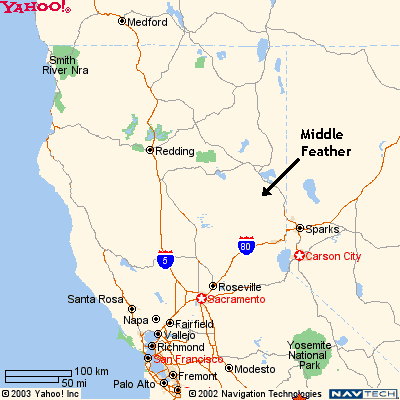
Click here to watch the video trip report for this river.
The Stanley/Holbeck guidebook doesn't mince words about Devils Canyon; their description begins with:
"This is it! The Middle Fork of the Feather River is the best wilderness self-support trip in California."
Who could resist such a description?
Over the years we had pieced together bits of information about this run from various sources, so we had a general sense of the surreal beauty of the canyons, the nature of the rapids, and the scale of the portage(s). We had also heard about the large, unportageable rapids in the final canyon, and that lost or broken gear would result in a survival scenario of epic proportions due to the towering canyon walls. All of this just made the run more appealing to me; I've always been irrisistably drawn to rivers like this.. like a moth to a flame, a cat to a highway.. you get the idea.
This run is known as 'Devils Canyon' but it actually consists of three canyons, each about ten miles long. The first canyon has no name and is generally bouldery and wide open. The second is known as Franklin Canyon and is narrower with more significant rapids and bigger walls. At the end awaits Devils Canyon proper, with huge granite walls and a number of large, powerful drops, some of which cannot be portaged. The entire river is pool and drop, with large recovery pools below every major rapid. The majority of the rapids are III to IV with about ten class V drops spread evenly throughout the run.
Everything about the Middle Feather is on an epic scale. The canyons, the scenery, the shuttle... Did I mention the 125-mile one-way shuttle? The ultra-remote nature of this river is heavily reinforced by a shuttle of mammoth proportions; you drive four miles for every one spent on the river. Nevertheless, the shuttle is actually a great drive, very scenic, and a small price to pay for three days spent on this fabulous river.
Note: This section has been designated and protected as a Wild and Scenic river, so access is limited to a few steep, rugged trails at the end of each canyon. The remoteness of this run demands an above-average level of preparedness. I think that extra food and a water filter are prerequisites, along with a bit of wet-weather gear in case you get surprised by a pesky summer Sierra thunderstorm.
The campground at Milsap Bar was nearly full, but somehow we managed to secure a wonderful spot overlooking the river. The mosquitoes were fierce and plentiful, but they scarcely dampened our spirits as we packed our boats and bedded down for the night, the roar of the river lulling us to sleep. (Fortunately the mosquitoes were almost non-existent while we were camping on the river.)
We were very eager to get on the river, so we loaded our gear, left my car parked out by the road, and hiked down to the river.

The river was very mellow for the first few miles, with lots of splashy class II-III drops and a few rugged frontier types panning for gold along the banks. The water was also startlingly warm, almost swimming-pool warm, and I wondered: Can this possibly get any better?
Soon all traces of civilization evaporated as we approached the first canyon and the walls shot up to the heavens. The rapids in the first canyon were wide, pool-drop bouldery affairs with multiple routes. The canyon itself had a generous, wide-open feel, with lots of nice places to stop, laze about in the sun, and soak up the scenery.

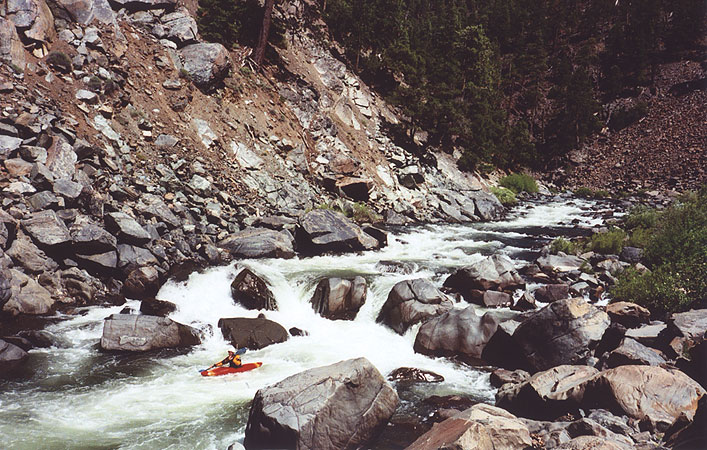
Soon the canyon opened up somewhat, and it was time to pick a campsite. We chose the first one, which is the spot described in the American Whitewater article 'Cruising Cali at 50'. This is a prime site, with a nice sandy beach on river right (I think it is a very old mining camp) and sun in the morning and evening. I spent the evening walking around on the warm beach squishing sand between my toes, thinking: "It doesn't get much better than this..."
Soon we reached a footbridge over the river which signaled the beginning of Franklin Canyon. The geology abruptly solidified and the river narrowed dramatically, and after running a few drops we got out above a large horizon line marking Franklin Falls. This waterfall drops about twelve feet into a large hole backed up by a submerged boulder, so we chose to walk it on river left (neither of us were confident that we could execute such a critical move with boats loaded down with camping gear). After seal-launching below this falls we immediately encountered another horizon line and got out on the left to scout. Here the river splits around a bedrock island, with the left side pounding down a narrow chute blocked by a log at the bottom. We ran the right side.
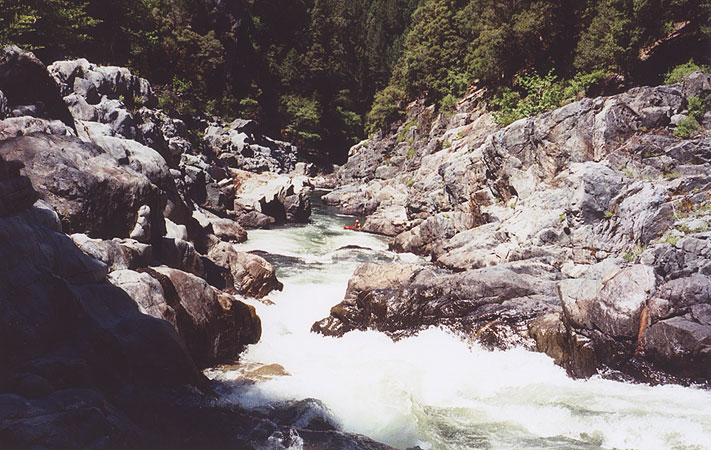
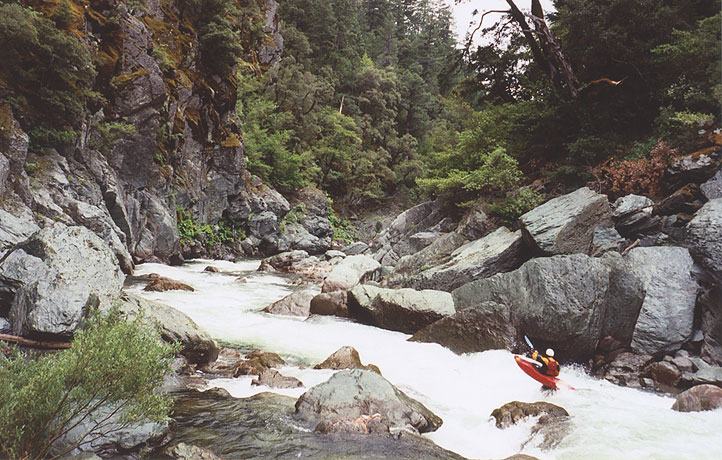
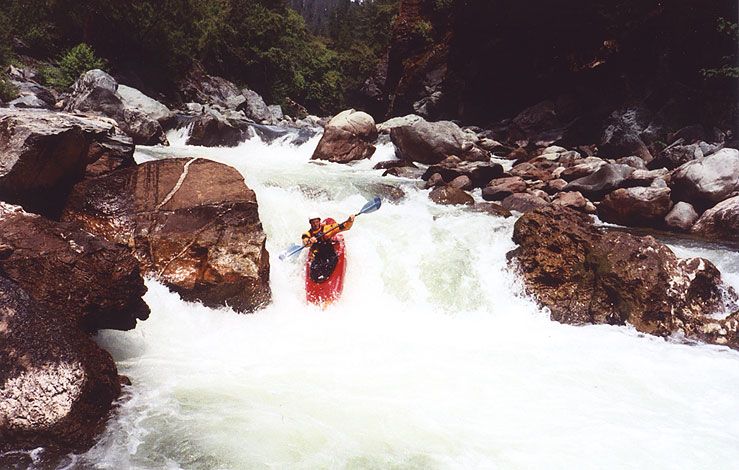
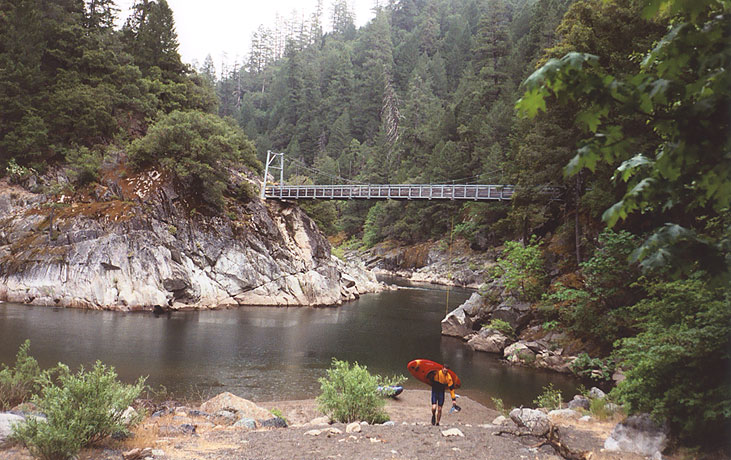
 Night Two: Josh and Jason's Quest for Fire..
Night Two: Josh and Jason's Quest for Fire..
The campsite at the end of Franklin Canyon is a little weird; this is one of the few external access points, and this coupled with the Pacific Crest Trail means a fair amount of hiking traffic. These unwelcome traces of civilization are a little disconcerting after the isolation of the previous twenty river-miles.
The campsite nearest the river appeared to be fairly well lived in; there was an ancient sleeping pad, tent, and some gnarly old food hanging from a tree. We avoided this spot and moved downstream to a nice site overlooking the river. (perhaps a gold miner was working the nearby shoals? We never saw anyone over there, so we never found out..)
By the time we reached the camp the thunderheads that had been looming overhead all day opened up and it started pouring. I muttered: "It never ceases to amaze me, how we seem to attract the rain every time we come to California; it simply defies reason.."
Of course, we were totally unprepared for a high Sierra summer thunderstorm, so we started casting about for firewood. Once we gathered a large enough pile I pulled the lighter out of my camera case.
I flicked the lighter and nothing happened.. Flick... Nothing.. Flick.. Flick.. FlickFlick FlickFlickFLICK... AAARRRGHHH!!
Our only source of fire was completely dead, the moisture in the camera case had rendered the flint useless.
"Well, Shit." I said as the rainwater trickled down my face. It was cold. We were both wearing shorts, and though I had a gore-tex bivy and a 15 degree down sleeping bag in my boat (Josh was similarly equipped), it was still early and we wanted a FIRE to dry out our gear!!
So we started scrounging. While Josh dug fruitlessly through the miner's campsite by the river, I scored a ziplock bag full of strike-anywhere matches from another site further down the river. Of course, these matches had been bone-dry before the rain started, but now there was water in the bag and my hopes wilted as one by one the matches refused to light. At this point I was crouched on the ground, striking the matches under a crude wooden bench someone had fashioned from logs near the fire pit. There was a narrow strip of precious dry ground under the bench, and I piled up the matches under there.
Finally, out of desperation, we started going through all of our gear. Josh opened his first aid kit, and SCORE! Out came a brand-new box of waterproof matches! "You da man!" I said to Josh as we both crouched under the bench and started striking his matches.
Nothing. Every one of his 'waterproof', 'strike-anywhere' matches broke or crumbled when he tried to strike them. "You've gotta be kidding me." Josh grumbled. "These matches SUCK!"
"Hey!" I said, "try striking these matches I got from the campsite on the side of your match box." (I had been striking them on a rock.) After four tries, one of the camp matches lit! "WHOO-HOOO!" I yelled, grabbing the lighter. Soon the lighter was going and we built a small fire under the bench. "Don't let that lighter go out." Josh said unnecessarily. "I'm going to get more dry twigs."
So there I was, crouching in the dirt under the bench, shielding the flame in the lighter with both hands, when I noticed that our meager little fire was going out. I leaned over to blow on the fire, the wind gusted, blowing it AND the lighter flame out..
"GAAAAH!" I yelled in frustration. "It went out!!"
Josh came running over. "They BOTH went out?" he said, sounding annoyed. "Yeah, damn it.." I muttered sheepishly. So he got down and started striking the matches again while I held the lighter at the ready. Our pile of matches had dwindled dramatically and the situation was looking increasingly grim when a match suddenly whooshed to life. I immediately lit the lighter, and this time I cupped my hand around the tiny flame and ignored the alarming pain in my thumb as the lighter grew dangerously hot. Just when I was pretty sure it was going to explode and burn my face off, a small puff of steam shot out of the top and I knew we were good to go. I let it go out, and it re-lit easily. "Hell YEAH." I said to Josh with a grin. "I think it's time for a gen-u-ine Ory-gun REDNECK FARRE.. yee haw!!"
Fifteen minutes later we had a huge blaze going, a redneck fire so hot you couldn't get within six feet of it!
Then, of course, it stopped raining..
I woke up late on the morning of day four; the sunlight was filtering down through a brilliant blue sky barely visible through the trees. Josh was already up, it must have been at least 10 a.m. and it was hot.
"Ugh." I muttered thickly, totally dehydrated. After gulping down what felt like a gallon of water, I forced myself out of my stupor and choked down a chocolate muffin. Feeling slightly more human, I joined Josh in packing up the camping gear.
After lazing around for a bit, we shouldered our boats and headed down to the river. The weather was great, and the water looked inviting.. "Let's go see what this Devils Canyon is all about.." I said to Josh with a grin.
Downstream the walls towered overhead, vertical, granite monoliths hundreds of feet tall. "This is it." I thought to myself.. "I've waited so long to see this place.."
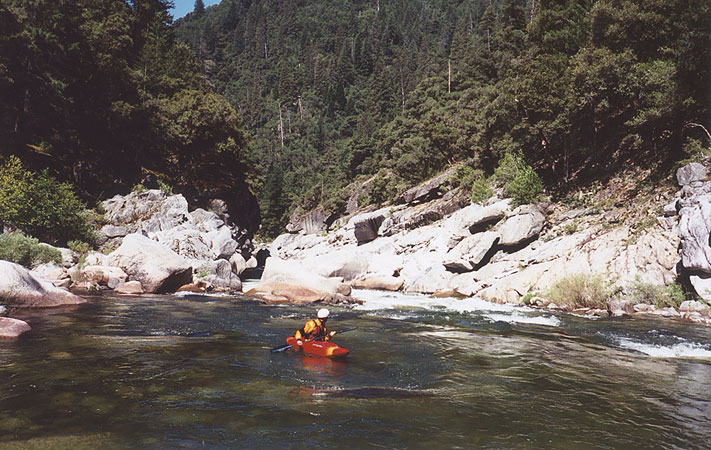
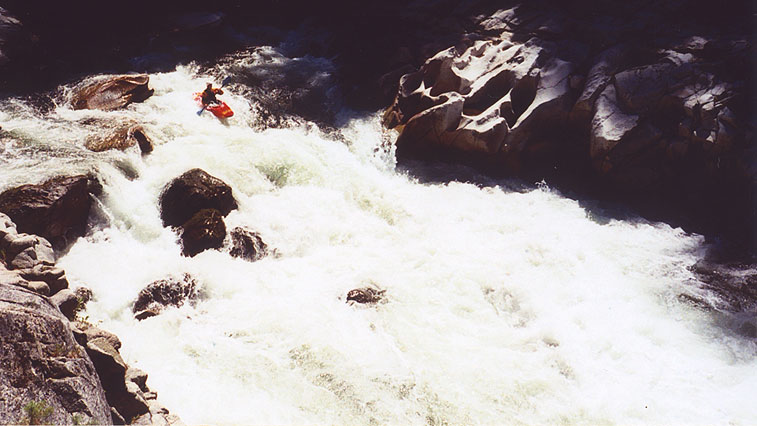
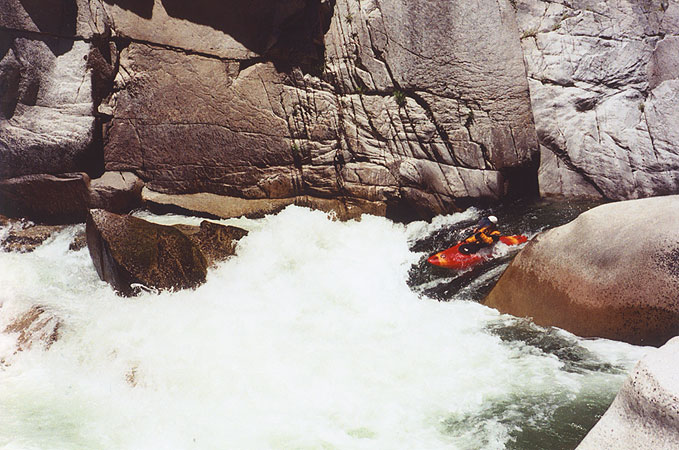
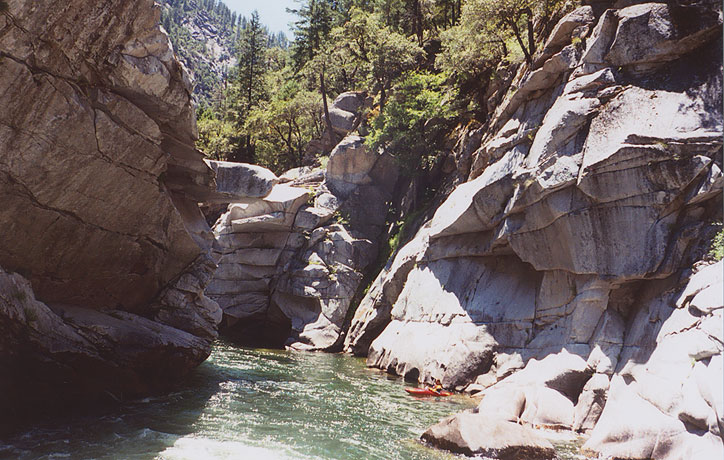
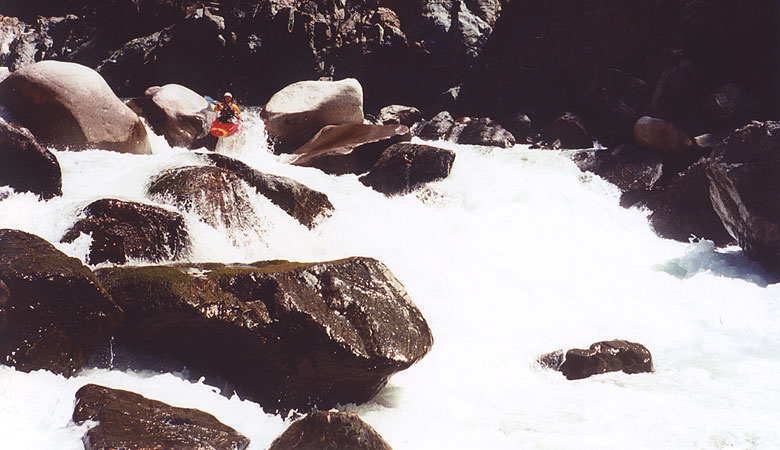
Soon we arrived at a large rapid marked by a huge diamond-shaped granite boulder on the bottom, river-left side. Without knowing how, I said: "This has to be the drop above the class six portage..." Sure enough, a quick scout revealed a massive horizon line below this drop, with a long, bottomless green pool separating the two.
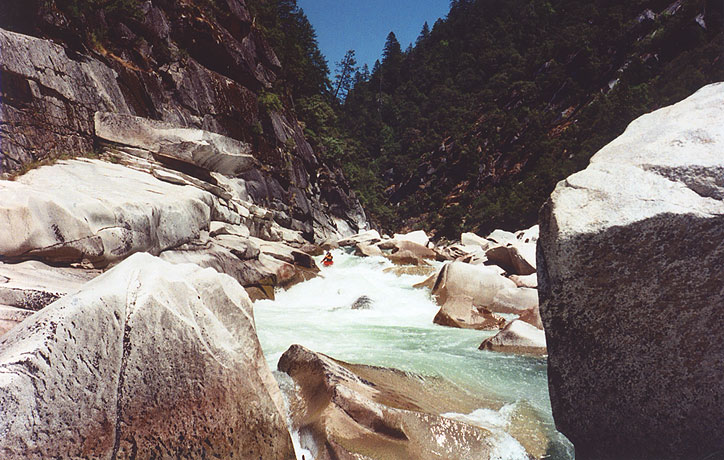
The class six was predictably horrible, with gigantic undercuts guarding the top of the rapid and nastiness to spare downstream. There is a very well-traveled trail traversing along the right wall, so I lazed about in the sun as Josh scouted the rapid. He was gone for a long time, finally deciding to walk it like the rest of us mortals after contemplating a few hideous undercuts. (Note: Be extremely careful when walking around on the slick, sloping granite shelf overlooking this rapid. I know of one very experienced paddler who slipped and fell into the river a few years ago while scouting this drop and narrowly avoided swimming the entire rapid... yikes!)
The portage took about ten minutes, and it wasn't too bad with a kayak, though it would be nightmarish with a raft. There were a few sketchy places where a slip could have been fatal, though, so sticky rubber is recommended.
The canyon surrounding the portage is the most spectacularly scenic part of the river; I shot some photos but they utterly failed to capture the majesty of the place. Huge, soaring granite walls echoing with the thunder of a massive class six cascade, boxed-in walls downstream.. "Yeah." I thought to myself. "This is what I came here for. This is it.."
Below the class six were more fun rapids, and the river was pretty well walled in at this point, no way to get out. Soon the walls opened up slightly but then closed in again as we arrived at "Helicopter" one of the large, must-run rapids in Devils Canyon.
At Helicopter the river careens down through a chaotic, foamy chute with increasingly larger holes culminating with a wild airplane turn off the left wall at the bottom into a large hole..

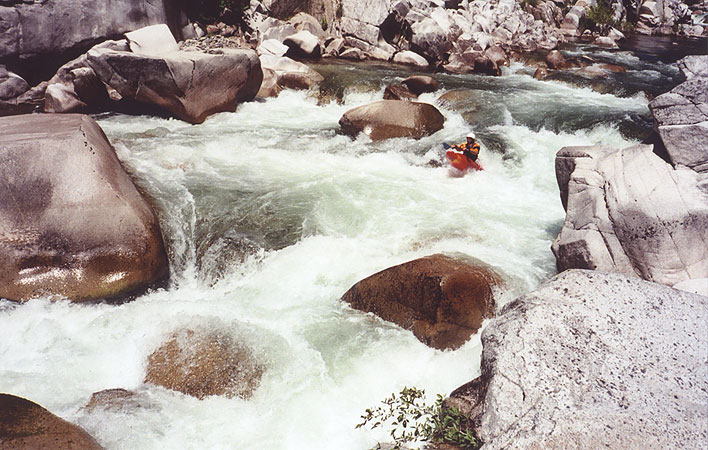
This was a great rapid, though the lead-in to the final drop was surprisingly pushy and tended to funnel you towards the right side of the river, where a large hole threatened to beat the be-frickin-jezus out of ya... neither of us ended up on the right, because we were both pulling like heroes when we approached the main drop..
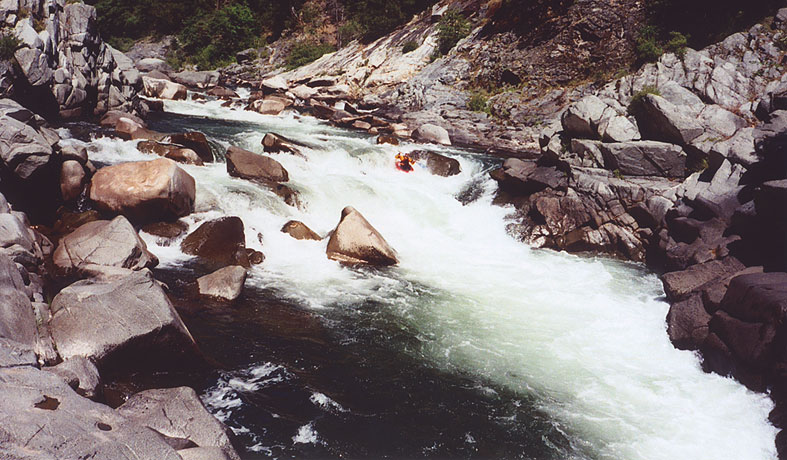
Things I wish I had known before I ran this river:
1. Summer thunderstorms are not unusual in the Sierras. They usually don't last more than a few hours, but sometimes they stick around for days. Pack a little extra gear in case you get stuck in one. (I know of one group who put on during a sunny day in June and then got rained on their entire trip, so it can happen!)
2. More water. We had about 750 cfs, but I think double that flow would be better, especially for the first day, when the river is wide and rocky. The guidebook talks about running this section between 500 and 3000 cfs, but I think their recommended minimum of 1000 cfs is right on the money.
3. Take your time! We moved pretty quickly down the canyons each day, not knowing how far we had to go before camping, and we always got to camp with plenty of daylight to spare. In some ways this was good in case of a mishap, but next time I think I'll go a little slower and enjoy the scenery a little more..
FLOWS and ACCESS: We ran the Feather at 750 cfs on the Milsap Bar internet gauge. The guidebook recommends 1000 minimum, and I would agree with this as the first day especially would be much more enjoyable with more water. For shuttle directions, pick up the Stanley / Holbeck guidebook, "The Best Whitewater in California."
To get to the put-in, the fastest way is to take I5 to 99 to Chico and then east from there. However, if you are heading north on the way home, the best way to go is to take 70/89 north out of Quincy up along Indian Creek (a kick-ass V-V+ run, by the way) and then on to highway 36, which joins I5 at Red Bluff. The scenery along this highway is great, and it's a pretty fast drive, not too windy.
Some of you may be wondering where in the heck this river is. Well, the Middle Feather cuts through the same range as the classic wilderness runs on Mill and Deer Creek, only slightly further south. In the picture below, I have pointed towards the approximate location of the put-in.
